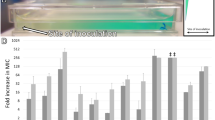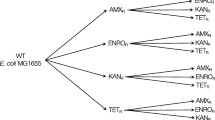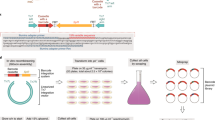Abstract
In this review we focus on the ecological and evolutionary forces that determine the frequency and diversity of colicins inEscherichia coli. To begin, we describe that this killing phenotype is ubiquitous inE. coli, with as many as 50% of the isolates from a population producing colicin toxins, and that each population sampled has its own unique distribution of the more than 20 known colicin types. Next, we explore the dynamics of colicinogeny, which exhibits a typical form of frequency dependence, where the likelihood of successful colicin invasion into a population increases as the initial density of colicinogenic cells increases. We then incorporate thoughts on the evolution of chromosomal resistance to colicins and describe how resistance might influence the dynamics of colicinogen invasion and maintenance and the resulting colicin diversity. The final section deals with a genetic and phylogenetic characterization of colicins and a discussion of the evolutionary mechanisms responsible for generating colicin diversity. In this final section we provide details of the different molecular mechanisms known to play a role in generating colicin diversity, including the two most dominant forces in colincin evolution: recombination and positive, deversifying, selection.
Similar content being viewed by others
References
Achtman M, A Mercer, B Kusecek, A Pohl, M Heuzenroeder, W Aaronson, A Sutton and RP Silver. 1983. Six widespread bacterial clones amongEscherichia coli K1 isolates. Infect Immun 39: 315–335.
Broda P. 1979. Plasmids. Freeman, San Francisco.
Campbell A. 1981. Evolutionary significance of accessory DNA elements in bacteria. Ann Rev Microbiol 35: 55–83.
Caugant DA, BR Levin and RK Selander. 1984. Genetic diversity and temporal variation in theE. coli population of a human host. Genetics 98: 467–490.
Chan PT, H Ohmori, J Tomizawa and J Lebowitz. 1985. Nucleotide sequence and gene organization of Col E1 DNA. J Biol Chem 260: 8925–8935.
Chao L and BR Levin. 1981. Structured habitats and the evolution of anticompetitor toxins in bacteria. Proc Natl Acad Sci (USA) 78: 6324–6328.
Cooke M, GT Hettiaratchy and AC Buck. 1972. The fate of ingestedEscherichia coli in normal persons. J Med Micro 5: 361–369.
Craven JA and DA Barnum. 1971. Distribution of porcine fecal coliflora throughout a barn. Can J Comp Med 35: 274–278.
De Lorenzo V and A Aquilar. 1984. Antibiotics for Gram-negative bacteria: do they play a role in microbial ecology? Trends Biochem Sci 9: 266–269.
De Vuyst L and E Vandamme. 1994. Bacteriocins of Lactic Acid Bacteria. Blackie Academic and Professional, London.
Di Masi DR, JC White, CA Schnaitman and C Bradbeer. 1973. Transport of vitamin B12 inEscherichia coli: common receptor sites for vitamin B12 and the E colicins on the outer membrane of the cell envelope. J Bacteriol 115: 506–513.
Florey H. 1946. The use of microorganisms for therapeutic purposes. Yale Medical School Publication.
Frank SA. 1994. Spatial polymorphism of bacteriocins and other allelopathic traits. Evol Ecol. 8: 369–386.
Govan J. 1986.In vivo significance of bacteriocins and bacteriocin receptors. Scand J Infec Dis 44: 31–37.
Hardy K. 1974. Colicinogeny and related phenomena. Bacteriol Rev. 39: 464–515.
Hill C and IB Holland. 1967. Genetic basis of colicin E susceptibility inEscherichia coli. I. Isolation and properties of refractory mutants and preliminary mapping of their mutations. J Bacteriol 94: 677–686.
Hughes A and M Nei. 1988. Pattern of nucleotide substitution at major histocompatibility complex class I loci reveal overdominant selection. Nature 335: 167–170.
Hughes A and M Nei. 1989. Nucleotide substitutions at class II MHC loci: evidence for overdominant selection Proc Natl Acad Sci (USA) 86: 958–962.
James R, C Lazdunski and F Pattus. 1991. Bacteriocins, Microcins and Lantibiotics. Nato ASI Series. Springer-Verlag, New York. 519 pp.
Konisky J. 1982. Colicins and other bacteriocins with established modes of action. Ann Rev Microbiol 36: 125–144.
Lau PCK, M Parsons and T Uchimura. 1992. Molecular evolution of E colicin plasmids with emphasis on the endonuclease types. In: Bacteriocins, Microcins and Lantibiotics (James R, C Lazdunski and F Pattus, eds), pp 353–378, Springer-Verlag, Berlin.
Lazdunski C and D Cavard. 1982. Colicins: a mini review. Toxicon 20: 223–228.
Lenski RE. 1988. Experimental studies of pleiotropy and epistasis inEscherichia coli. I. Variation is competitive fitness among mutants resistant to virus T4. Evol 42: 425–432.
Levin BR. 1988. Frequency-dependent selection in bacterial populations. Phil Trans Roy Soc Lond B 319: 459–472.
Luria SE and JI Suit. 1987. Colicins and col plasmids. In:Escherichia coli andSalmonella typhimurium: Cellular and Molecular Biology. (Neidhardt FC, et al., eds), pp. 1615–1622, American Society for Microbiology, Washington, DC.
Mankovich J, C Hsu and J Konisky. 1986. DNA and amino acid sequence analysis of structural and immunity genes of colicins Ia and Ib. J Bacteriol 168: 228–236.
Mock M and AP Pugsley. 1982. ThebtuB group Col plasmids and homology between the colinins they encode. J Bacteriol 150: 1069–1076.
Nagel de Zwaig R and SE Luria. 1967. Genetics and physiology of colicin-tolerant mutants ofEscherichia coli. J Bacteriol 94: 1112–1123.
Nomura M and C Witten. 1967. Interactions of colicins with bacterial cells. III. Colicin-tolerant mutations inEscherichia coli. J Bacteriol 94:1093–1111.
Pugsley AP. 1984. The ins and outs of colicins. Microbiol Sci 1: 168–175, 203–205.
Pugsley AP and B Oudega. 1987. Methods of studying colicins and their plasmids. In: Plasmids, a Practical Approach (Hardy KG, ed), pp 105–161, IRL Press, Oxford.
Reanney D. 1976. Extrachromosomal elements as possible agents of adaptation and development. Bacteriol Rev 40: 552–590.
Reeves P. 1972. The Bacteriocins. Springer-Verlag, New York.
Riley MA. 1993. Molecular evolution of colicin. Mol Biol Evol 10: 1048–1059.
Riley MA, 1993. Positive selection for colicin diversity inEscherichia coli. Mol Biol Evol 10: 1380–1395.
Riley MA and DM Gordon 1992. A survey of Col plasmids in natural isolates ofEscherichia coli and an investigation into the stability of Col-plasmid lineages. J Gen Microbiol 138: 1345–1352.
Roos U, RE Harkness and V Braun. 1989. Assembly of colicins genes from a few DNA fragments, nucleotide sequence of colicin D. Mol Microbiol 3: 891–902.
Schramm E, J Mende, V Braun and R Kamp. 1987. Nucleotide sequence of the colicin B activity gene cba consensus pentapeptide among TonB-dependent colicins and receptors. J Bacteriol 169: 3350–3357.
Selander RK, DA Caugant and TS Whittam. 1987. Genetic structure and variation in natural populations ofEscherichia coli. In:Escherichia coli andSalmonella typhimurium: Cellular and Molecular Biology (Neidhardt FC,et al., eds), pp 1615–1622, American Society for Microbiology, Washington, DC.
Strobeck C. 1983. Expected linkage disequilibrium for a neutal locus linked to a chromosomal arrangement. Genetics 103: 545–557.
Tadd AD and A Hurst. 1961. The effect of feeding colicinogenicEscherichia coli on the intestinalE. coli of early weaned pigs. J Appl Bacteriol 24: 222–228.
Tagg JR, AS Dajani and LW, Wannamaker. 1976. Bacteriocins of gram positive bacteria. Bacteriol Rev 40: 722–756.
Veltkamp E and AR Studtje. 1981. Replication and structure of the bacteriocinogenic plasmids Clo DF13 and Col E1. Plasmid 5: 76–99.
Ward RJ, SE Hufton, NA Bunce, AJP Fletcher and RE Glass 1992. A structure-function analysis of BtuB, the vitamin B12 outer membrane transport protein. In: Bacteriocins, Microcins and Lantibiotics (James R, C Lazdunski and F Pattus, eds), pp 353–378, Springer-Verlag, Berlin.
Waters VL and JH Croza. 1991. Colicin V virulence plasmids. Microbiol Rev 55: 437–450.
Webster RE and SK Levengood. 1992. TolA: structure, location and role in the uptake of colicins. In: Bacteriocins, Microcins and Lantibiotics (James R, C Lazdunski and F Pattus, eds), pp 353–378, Springer-Verlag, Berlin.
Whittam TS. 1989. Clonal dynamics ofEscherichia coli in its natural habitat. Ant van Leeu 55: 23–32.
Author information
Authors and Affiliations
Rights and permissions
About this article
Cite this article
Riley, M.A., Gordon, D.M. The ecology and evolution of bacteriocins. Journal of Industrial Microbiology & Biotechnology 17, 151–158 (1996). https://doi.org/10.1007/BF01574688
Received:
Accepted:
Issue Date:
DOI: https://doi.org/10.1007/BF01574688




